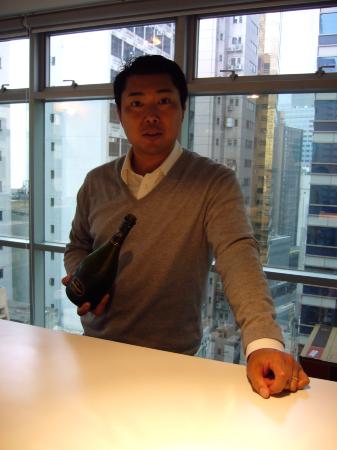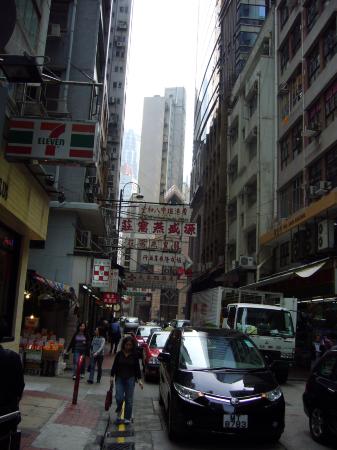Earlier this week aging Goth Robert Smith from The Cure was hailed a “Godlike Genius” by NME magazine. Simon Tam, director of the Independent Wine Centre in Sheung Wan (Hong Kong) and wine adviser to several Asian pop stars, claims the same for Meerlust winemaker Chris Williams. Simon started off calling him “God” before launching on an even more hyperbolic trajectory, comparing Chris to “a young Brian Croser” on the evidence of his miraculous Foundry Syrah.

It was 10:30am and we’d only had a couple of glasses of Dom Ruinart ’98 Blanc de Blanc. “Quite yeasty with a high dosage which makes it very ready. I really do prefer their old style before they were gobbled up by LVMH. My iPod has just blown so sorry there’s no acid jazz or Miles Davis” in his glass box office above busy Wing Lok Street.
Simon’s opinion is quite sound as he’s no inside trader, noting “we’re completely independent and pay for all our tasting samples” for offices in Shanghai, Macau and one about to open in Beijing. Born in Hong Kong but brought up in Adelaide, Simon trained as a winemaker at Roseworthy (“it took me four years instead of the usual three as the parties were so good”), is also a qualified chef (“European style, I come from a family of chefs”) as well as a qualified cheese maker (“so much for the myth that Chinese don’t eat cheese. I leave the cheese on my Big Mac.”)
Married to a Canadian Chinese with an Australian Chinese winemaker assistant, Simon can “flick between cultures” and describes himself as “a cultural marketer. We bring the delicious West to the thirsty East. We offer a full spectrum of tastings: from affordable ones to vertical Dom Pérignon, cheese, saffron, olive oil and coffee tastings.”
Established 17 years ago, his wine education business is the oldest in Hong Kong and Simon notes “we have a huge client base of women in the 25-35 age cohort. Prior to the return of Hong Kong to China in 1997, 90% of our clients were Westerners. This has now flipped to 90% Chinese. Chinese women don’t have anything to prove and outnumber men 3:1 on our courses. Men are typically over 35 and are suspicious about paying for lifestyle training, with the exception of the Pink Dollar sector which has replaced frivolity with a desire to know why. We don’t offer the Grand Poo-Bah courses of WSET as they’re culturally inappropriate. I don’t care about Greek wine, I’d far rather learn about the affect of bush fires on grape flavours.”

On the subject of the existence of an Asian Palate, Simon starts off by pointing to the European/American taste divide and confirms that the Chinese palates is different again. Which is why as director of the Hong Kong International Wine & Spirit Competition which takes place in November, he is assembling an army of Chinese judges from Singapore in the south, Taiwan in the east and Beijing in the north and predicts the gold medalists and trophy winners will be “60-70% different than those chosen by a Western panel.”
What do Chinese judges look for? “Harmony is an important criterion. Integration and flavour sweetness. We eat salted dry fish and preserved cabbage that you might consider disgusting. There is a broader palate of flavours and we eat consommé style soups with every meal. We have a lot of experience with liquids.” As in US politics, a change is sure to come although “we don’t have the confidence to break through Parker points or disagree with Jancis [Robinson]. Yet.”
On the controversial subject of Chinese wine, conspicuous by its absence in many fine dining restaurants in Hong Kong, Simon is very upbeat. “After leaving Roseworthy I sold yeast and filter pads in China for a while. Every Honky [Hong Kong resident] who spends a weekend in China becomes an instant expert on Chinese wine but I think it’s reckless for them to pass comment. China is now the 6th largest grape producer in the world and in addition they import another 40% of their production as bulk wine which they blend with their own. Sure, Chinese wines do not have the profile they deserve outside China, but that’s because the distribution system is a joke.”
Simon goes on to make the point that the modern Chinese wine industry dates back to the seventies as a countertrade initiative to balance huge sales of Cognac. “The Chinese government said: you’re from France, come and plant vineyards here. The cuttings were dubious and vineyards were established in fertile valleys and flatland without consideration for quality. Farmers were paid the same amount to produce table and wine grapes so quality suffered.”
Simon compares mainland wine drinkers to those parochial tipplers in Bordeaux and Burgundy who only drink the product of their own appellations. At the £3 a bottle supermarket level, Simon reckons that Chinese brands “are fiercely competitive. That said, there are also single vineyards Cabernets and Syrahs at many hundreds of Yuan a bottle made by Australian consultants. There is no tax and minimal transport costs on locally produced wines so they compete very well with imported Puligny Montrachet that has huge carbon miles and 40-60% import duty.”
As for SA exports to Hong Kong, while Simon notes there is “absurd value for money. Wholesale prices of HK$30 sell for HK$160” it is “a one-sided relationship. SA still does not have a value for money reputation and the Chinese are quick to put you in a box and screw down the lid so it’s very difficult to escape. SA’s box is cheap and cheerful and your labels are very difficult to read with all the Dutch on them. KWV’s top stuff is not here yet and although we do have Columella and Palladius, volumes are tiny.”
That said, Simon says the game is certainly worth the candle. “It’s carte blanche out here and Chinese are everywhere in the world. We’re hungry brand-builders. The Hong Kong market is far from saturated and we have a responsibility to show what a Chinese city can do with wine.”



